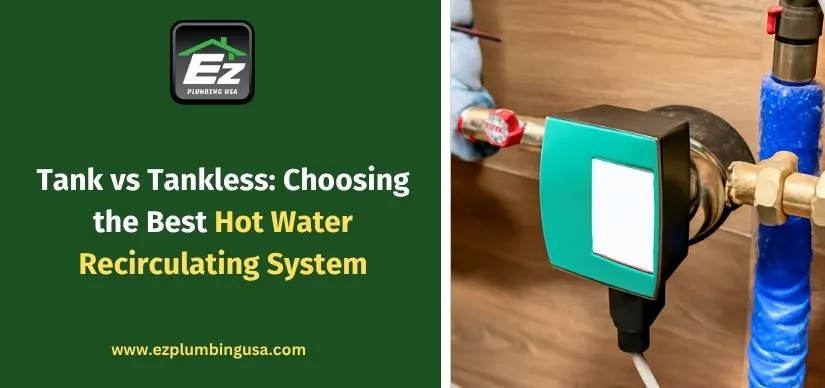Tank vs Tankless: Choosing the Best Hot Water Recirculating System
Views : 237

Understanding Hot Water Recirculating System
Tank Hot Water Recirculating Systems
How They Work
- Immediate Hot Water: Stored water is always hot and ready to use without delay.
- Simplicity: Tank systems are easy to install and compatible with most homes.
- Lower Initial Cost: These systems generally have lower upfront expenses than tankless systems.
- Easier Maintenance: Components are typically more accessible and repair costs are lower.
- Higher Energy Consumption: Constant heating leads to higher utility bills, especially in colder regions.
- Limited Supply: If hot water usage exceeds tank capacity, you may experience cold water until the tank reheats.
- Space Requirements: These systems require more physical space and may not fit in compact home designs.
Tankless Hot Water Recirculating Systems
How They Work
Pros
- Energy Efficiency: Only heats water when needed, reducing energy bills significantly.
- Unlimited Hot Water: No risk of running out of hot water, even during back-to-back showers.
- Space-Saving: Compact design fits neatly in tight spaces like closets or utility rooms.
- Longer Lifespan: Tankless systems can last 20 years or more with proper maintenance.
- Higher Upfront Cost: Installation and equipment can be twice as costly as tank systems.
- Flow Rate Limitations: May not support multiple simultaneous users without performance issues.
- Complex Installation: Often requires upgrades to plumbing and electrical systems.
Cost Comparison
- Installation: Tank systems typically range from $500 to $1,200, while tankless systems can cost between $2,000 and $4,500.
- Energy Bills: Tankless systems offer 20–35% savings in energy consumption.
- Maintenance: Annual maintenance is essential. While tank systems need flushing and occasional part replacements, tankless systems may require descaling to prevent mineral buildup.
- Lifespan: Tank systems last 10–15 years, while tankless systems can last over 20 years, offering better ROI in the long term.
Efficiency and Performance
Key Factors to Consider
- Household Size: Larger families may benefit from the steady supply of a tank system.
- Usage Patterns: Frequent, low-volume use is ideal for tankless systems.
- Installation Space: Smaller homes benefit more from compact tankless systems.
- Plumbing Compatibility: Older homes may require extensive plumbing changes for tankless systems.
Choosing the Right Water Recirculation Pump
- Timer-Based Pumps: These pumps run at scheduled times to maintain hot water availability.
- Thermostatic Pumps: These are controlled by water temperature, circulating water only when needed.
- On-Demand Pumps: Operated by the user, offering full control over when water circulates.
- Faster Hot Water: Reduces wait times to near zero.
- Water Conservation: Prevents thousands of gallons of waste yearly.
- Energy Efficiency: Can be paired with smart controls for maximum savings.
Installation Considerations
- Pipe Length: Longer piping systems benefit more from recirculation.
- Plumbing Access: Retrofitting can be easier with exposed piping.
- Electric Supply: Tankless systems may need upgraded circuit breakers.
- Water Quality: Hard water can reduce system lifespan without softeners.
Maintenance Tips for Long-Term Use
- Flush Tanks Annually: Prevents sediment build-up.
- Descale Tankless Units: Especially in areas with hard water.
- Inspect Pumps: Check for leaks or unusual noise.
- Monitor Efficiency: Track energy bills and water pressure to catch issues early.
Environmental Impact
- Water Savings: Up to 12,000 gallons annually.
- Energy Reduction: Especially with tankless units paired with a Water Recirculation Pump.
- Reduced Carbon Footprint: Lower reliance on municipal water heating.
- Support Green Goals: Qualifies for energy efficiency rebates in some states.
Tank vs Tankless System at a Glance
- Tank System Pros: Lower cost, simple installation, reliable flow.
- Tank System Cons: High energy usage, large space requirement, limited supply.
- Tankless System Pros: Efficient, endless hot water, compact.
- Tankless System Cons: High cost, needs upgrades, flow rate issues.
- Pump Options: Timer-based, thermostatic, on-demand.
- Pump Benefits: Energy and water savings, fast access, better user control.
Conclusion
FAQ'S
1. What is the main difference between a tank and a tankless hot water recirculating system?
Tank systems store hot water, while tankless systems heat it on demand. Tankless units are more energy-efficient, but tank systems offer consistent flow.
2. How does a water recirculation pump work in these systems?
The pump circulates hot water through pipes, minimizing the wait time at taps. It can work on timers, thermostats, or user commands.
3. Is a tankless system suitable for large families?
Yes, especially if equipped with the right flow rate and pump, though multiple units may be needed for high demand.
4. Which system is more cost-effective in the long run?
Tankless systems often save more over time through lower energy bills, despite their higher upfront cost.
5. Can I retrofit a hot water recirculating system in my existing home?
Yes, most homes can accommodate either system with proper plumbing modifications. On-demand pumps are ideal for retrofitting.

.jpg)

.jpg)
